Disclosure: Joyfully Domestic may earn a commission for purchases made after clicking links on this page. View our disclosure policy for details.
In this post, I’m sharing how we begin our school days and what is included in our morning time in our Traditional Catholic + Classical Charlotte Mason homeschool.
In the busyness of family life, it’s easy to feel like the day begins before we’ve even had a chance to breathe. Morning Time—often called the Morning Basket is chance to slow down together as a family.
It is a gentle, sacred beginning to the homeschool day, inviting the whole family to pause, gather, and turn their hearts toward what is True, Good, and Beautiful.
After all, the ultimate goal is towards union with God.
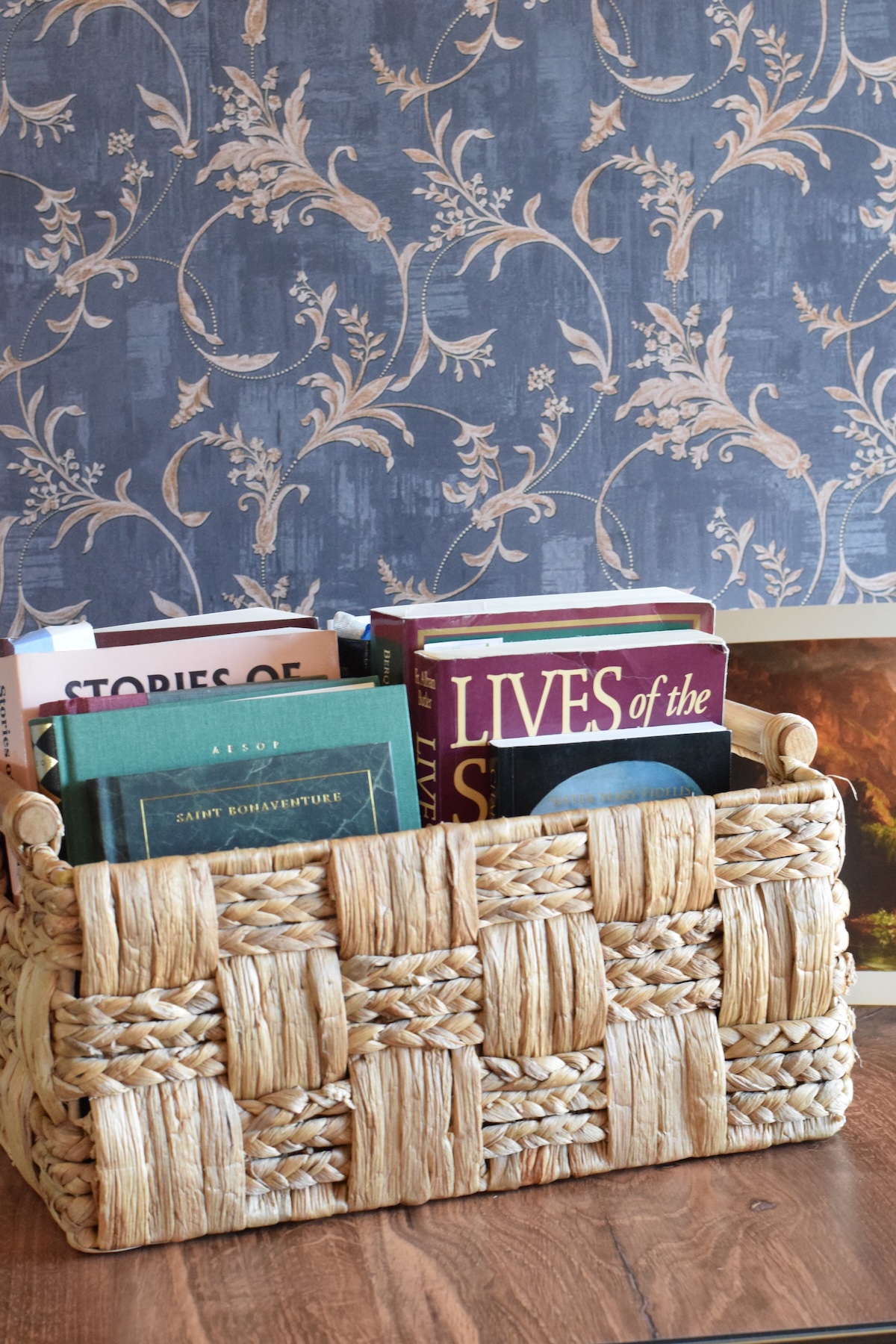
In a Classical Charlotte Mason home, especially one shaped by the Catholic vision of contemplation and wonder—Morning Time becomes the anchor of the day. It is not a lesson block but kind of like a liturgy of learning, a shared encounter with ideas that shape the imagination and nourish the soul.
Whether you are new to Charlotte Mason or simply longing to bring more beauty and peace into your home, here is what Morning Time can look like.
Remember, every family is different. And I’m merely sharing what works for ours in hopes that it is helpful to someone else.
What is morning time?
Morning Time (often called Morning Basket or as TCT calls it, Benediction Table) in a Classical Charlotte Mason homeschool is a gentle, beautiful way to begin the day with Truth, Goodness, and Beauty.
It sets the tone for the entire home atmosphere—unhurried, contemplative, and oriented toward God. While every family will shape it differently, here’s what it typically looks like in our home following a Classical CM approach, and a Traditional Catholic vision of wonder.
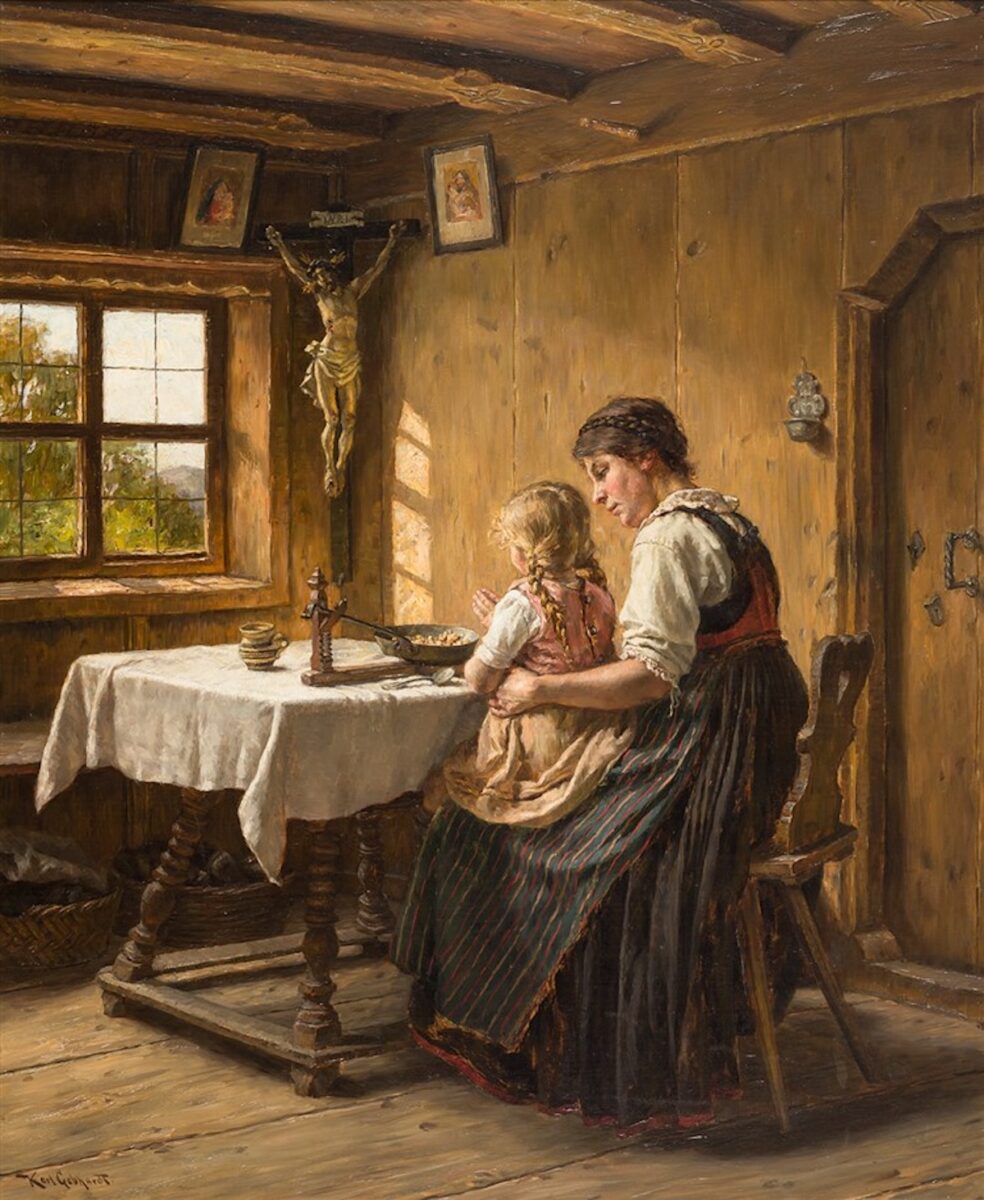
A Gentle and Peaceful Gathering
Morning Time usually begins with everyone coming together at the table or in a cozy reading nook. We enjoy our time together in the living room before moving to the classroom or breaking off for individual lessons.
There is no rush, no pressure; just togetherness and a simple invitation to begin the day well. Some families light a candle and others open the blinds to welcome in the morning light.
Some begin with quiet music or a moment of silence. I like to play gentle Classical music or more often, Palestrina –– as a signal to slow down chores and gather together.
This is the unhurried atmosphere that Charlotte Mason believed education thrives in—peaceful, relational, and attentive.
Opening Prayer & Devotion
For Catholic families, Morning Time often begins with a moment of recollection:
- A short prayer
- Reading from Scripture
- The Saint of the day
- A brief virtue reflection or intention
- Singing of hymns
These few minutes orient the entire day toward God. Before any academics begin, the children encounter what is highest and holiest.
Morning Time in the Domestic Church becomes a small “domestic monastery bell,” calling everyone back to God and grounding the school day in a spirit of contemplation.
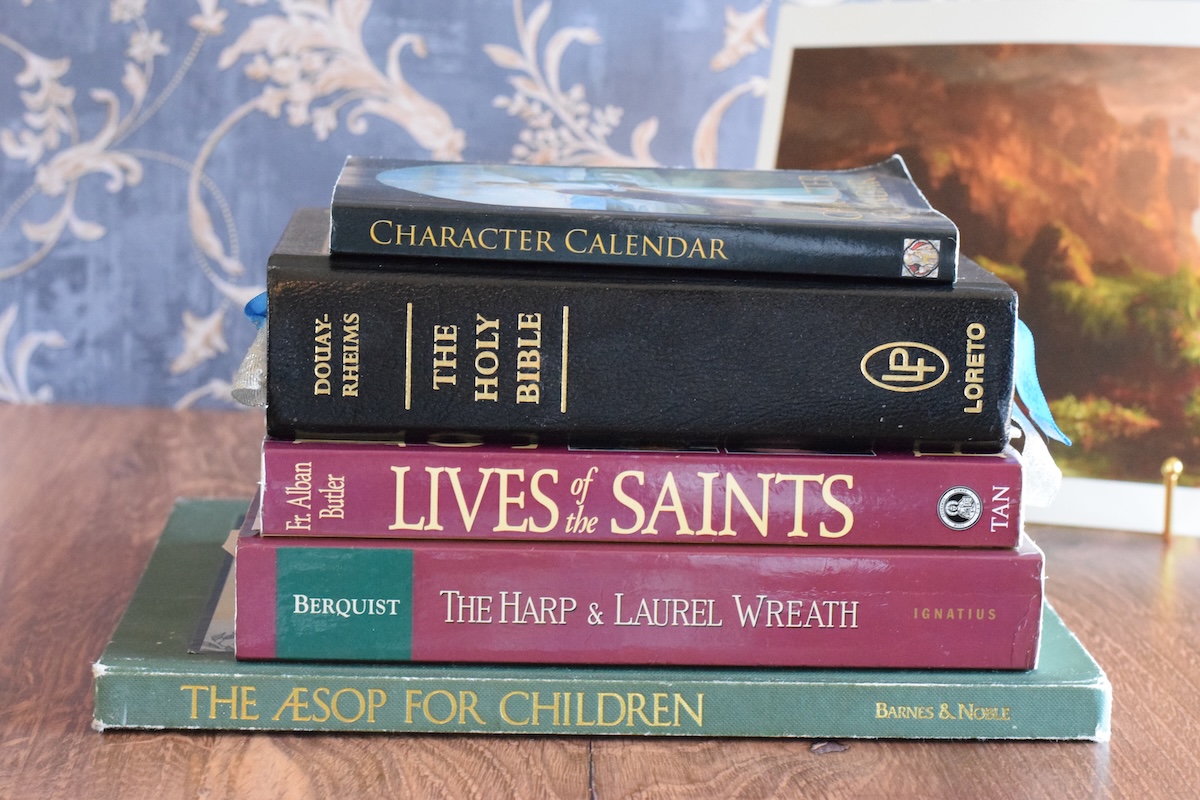
These books (pictured above) are our core readings that we begin our morning time with each day. We have been reading and re-reading through Aesop for several years now. Whenever we finish the book, we start it all over again.
For my older students, they read through this version independently. But truthfully it is a bit tedious to read aloud, so they do it on their own with narration afterwards.
These are read/reviewed daily:
- Character Calendar
- Douay-Rheims Bible <–– This is the version that I read from daily. And my children each have their own copy of this one: Douay-Rheims Bible
- Lives of the Saints
- The Harp and Laurel Wreath –– they also have their own copy
- The Aesop for Children
- Manner of the Week Flashcards
Devotionals / Spiritual Formation
We alternate between a devotional or another short reading as part of our spiritual formation (twice weekly).
Some of our favorites are the TAN Resurrection series. We also enjoy reading the seasonal devotional books by St. Alphonsus Ligouri.
Here are a few other favorites:
- The Mass Explained to Children
- Saints and Festivals: A Cycle of the Year for Young People
- The Book of Saints & Heroes
- A Child’s Life of Christ
- My Path to Heaven: A Young Person’s Guide to the Faith
- The King of the Golden City: An Allegory for Children –– this is a great Catholic alternative to Pilgrim’s Progress. And here is the special boy’s edition.
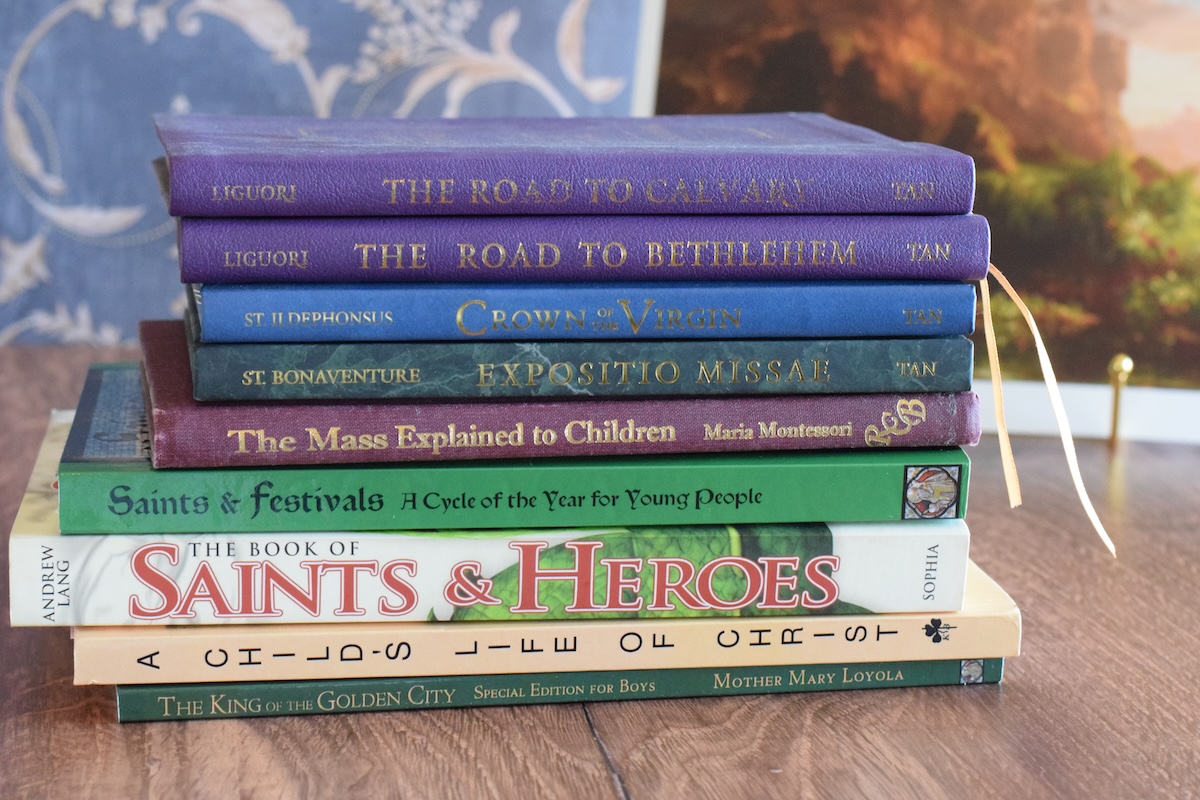
I have also shared more Bible and Catechism resources here.
Recitation + Memory Work
Charlotte Mason described recitation as “beautiful thoughts beautifully spoken.” In a classical CM home, recitation is not drilling or memorization for its own sake. It is cultivating the love of language.
Here’s a few recitation ideas:
- A Psalm or short Scripture passage
- A poem
- A Latin prayer (such as the Gloria Patri, Pater Noster, Ave Maria, or Sanctus)
- A catechism answer
- A favorite literary passage
Children absorb noble language naturally, joyfully, and without pressure. Recitation becomes a storehouse of beauty in the memory.
They also get plenty of memory work time sprinkled in throughout our time table.
A Rotation of “Beauty Subjects”
After prayer and devotional readings, this is the heart of the Morning Basket: short, rich lessons that awaken the senses and stir the imagination.
I would suggest to choose just one or two of these each day, rotating them throughout the week:
Poetry
A single poem each morning—sometimes the same poet for an entire term—deepens the child’s sense of rhythm, beauty, and imagination.
We use The Harp and Laurel Wreath most often. But also rotate through other options depending on the season.
Here are a few favorites:
- The Harp and Laurel Wreath
- Come Hither
- The Child on His Knees
- Lullabies and Poems for Children (Everyman’s Library Pocket Poets Series)
- Christmas Poems (Everyman’s Library Pocket Poets Series)
- Poems Every Catholic Should Know
- Poems Every Child Should Know

Read-Aloud Literature
A chapter from a living book: history, a fairy tale, saint story, nature lore, or a classic children’s novel.
You may also enjoy reading about Fairytales, Fables, Legends, and Myths in a Catholic Education.
Artist Study
Children study one artist per term by looking at a single painting at a time and narrating what they notice. We usually do this along with composer study and Shakespeare as part of our “Fine Arts Fridays”.
Related: Charlotte Mason Picture Study as Formation in Wonder
Composer or Hymn Study
Listening to the music of the composer of the term or learning a hymn or folk song invites children to experience truth through beauty.
How we approach Musical Education in our Classical Homeschool.
Nature Lore
Short readings that teach children to observe and love the natural world God created. The Burgess books are always a favorite in many Charlotte Mason homeschools.
One of our current favorites is Star Stories. And I’ve also shared a few other nature books in this post.
Shakespeare
Often read once a week using a child-friendly retelling, with occasional recitation or dramatization.
Related: Shakespeare in our Classical Homeschool + Favorite Resources
Latin
A simple daily practice: one prayer, a short vocabulary word, or a chant—keeps the study of Latin gentle and accessible. Usually just a brief review is all that we do in our morning block.
Virtue or Character Training
Through Aesop’s fables, Scripture, saints’ lives, or stories of noble deeds.
These small “feast items” cultivate a love for beauty and lay the foundation for lifelong wonder.
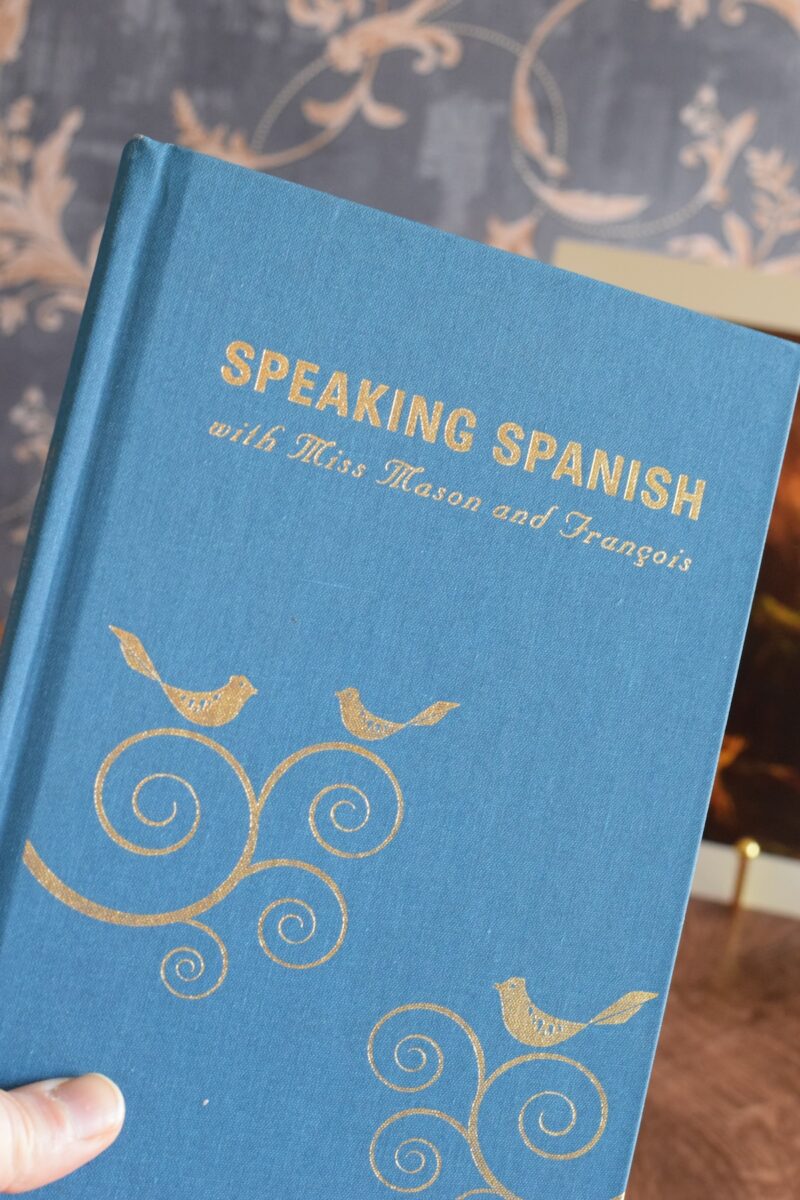
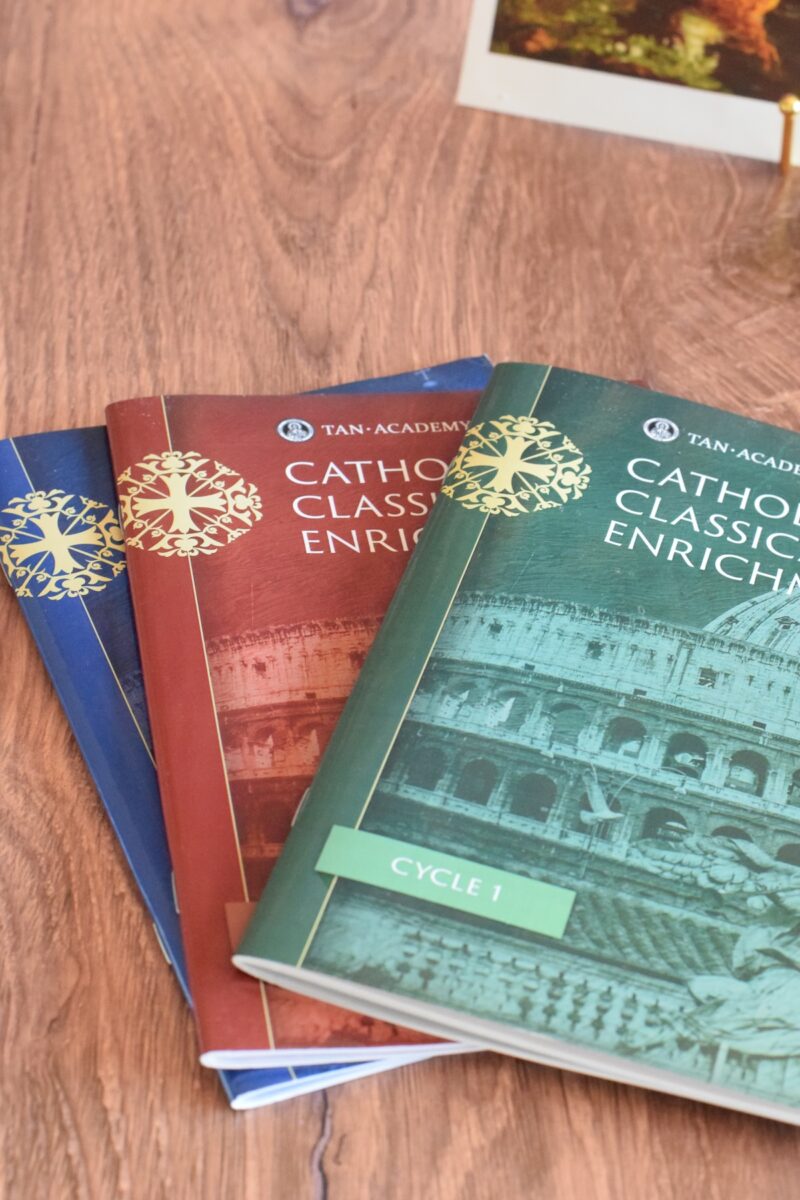
Lastly, we add in about 5 ish minutes or so for a short Spanish lesson or through this Catholic Classical Enrichment on audio.
Narration & Gentle Family Discussion
After short readings, children narrate what they heard or simply share what they noticed. This slow, reflective conversation strengthens attention, memory, and understanding. And without quizzes or worksheets.
This is such a lovely time together as a family.
Narration helps children become attentive listeners and thoughtful speakers, training them to truly know rather than simply check off a lesson.
More on narration can be found here: The Art of Narration in a Classical Charlotte Mason Education
Short, Simple, and Consistent
Morning Time is not meant to stretch on for a long period. Here’s an example of what it could look like…
- Little ones: 20–30 minutes
- Mixed ages: 30–60 minutes
- Larger families or older students: 45–90 minutes
Generally, our morning time lasts for just about an hour.
The goal is not to do everything, but to consistently offer your children a beautiful beginning to the day. And remember to keep it joyous and full of beauty.
A Sample Morning Time for a Catholic Charlotte Mason Home
We begin our morning time right after breakfast and chores are finished, usually around 8 am. Here’s a basic overview of what it looks like:
- Prayer, Bible (we alternate between OT & NT), hymns, Psalm, Lives of the Saints, Devotionals/Spiritual Formation, Read Aloud, Habits/Manners (30 min)
- Fables, Poetry, other Beauty “Subjects”, Recitations (20 min)
- Spanish, Latin review, folk songs, classical enrichment (10 min)
And we loop through or alternate days with our readings.
I put together another simple sample or breakdown of what morning time could look like as an example.
Here is a simple model you can adapt:
1. Opening (5-10 min)
- Sign of the Cross (we have begun practicing this in Latin as well)
- Morning prayer
- Scripture verse
- Saint of the day
- Hymns
2. Recitation (5–10 min)
- Psalm
- A poem
- Latin prayer
3. Beauty Loop (choose one or two per day, 10–15 min)
- Monday: Nature Lore
- Tuesday: Composer/Hymn Study
- Wednesday: Shakespeare
- Thursday: Artist Study
- Friday: Folk Song or Poetry Tea
4. Read-Aloud (10–20 min)
A living history, literature, or nature book.
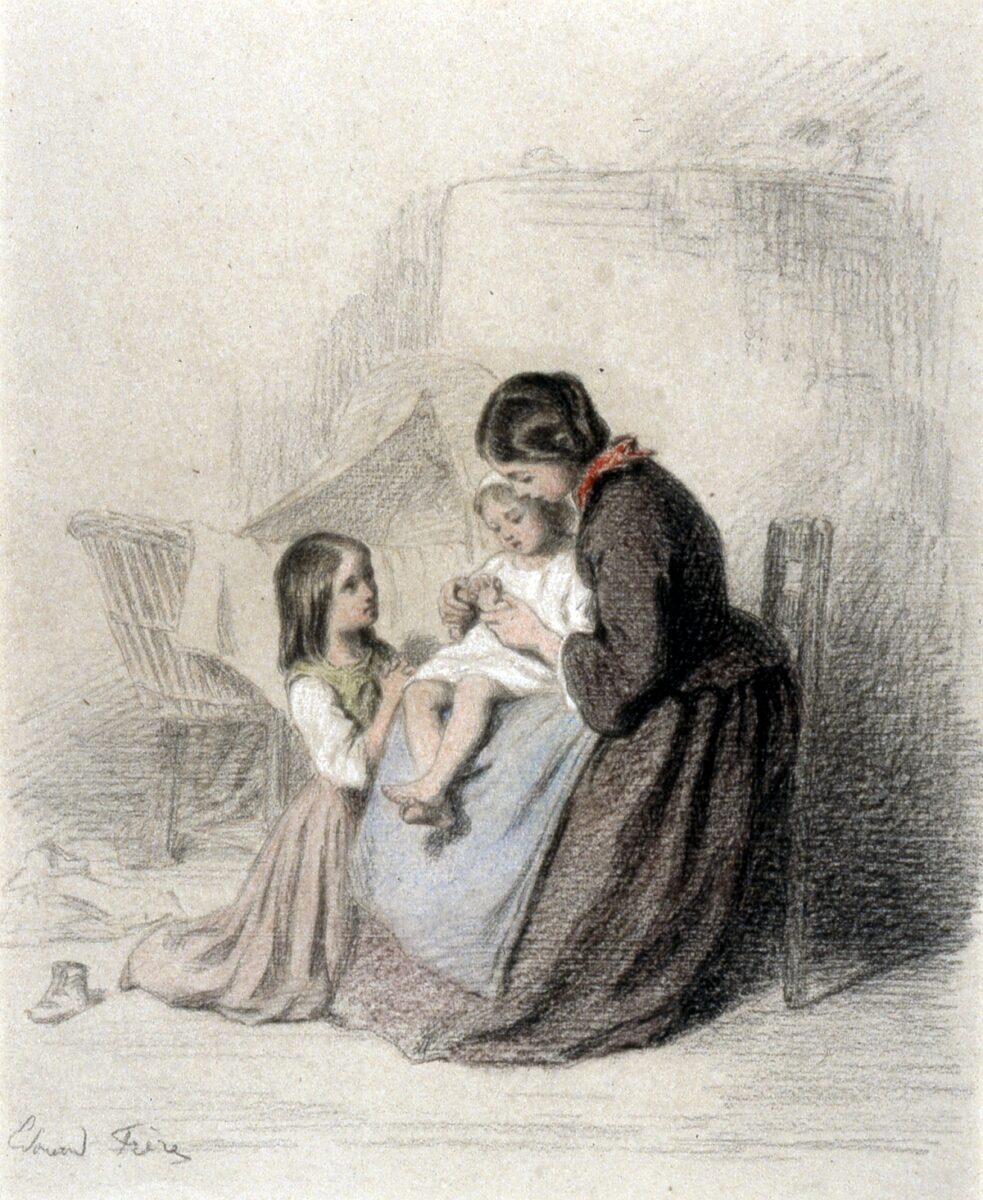
Why Morning Time Matters
I’m going to close with a last brief praise for why you should consider adding morning time into your homeschool day (if you’re not already).
In a world full of distraction, Morning Time restores rhythm and sacredness to home education. It brings your family together around shared prayer, shared beauty, and shared wonder.
And remember, as Charlotte Mason says, “Education is an atmosphere, a discipline, a life.” By building the habit of morning time, we are providing our children with a life full of richness.
- It helps you slow down.
- It enriches your home atmosphere.
- And it sets a tone of peace for the rest of the day.
But most of all, it becomes one of the most treasured memories of childhood—a daily ritual of learning, loving, and growing together.
Because, that’s the point, after all.
What stands out to you from these ideas?
I hope that you found this post helpful. And I’d love to hear what resonates most! Tell me what you’d add and/or share your favorite morning time resources with us!

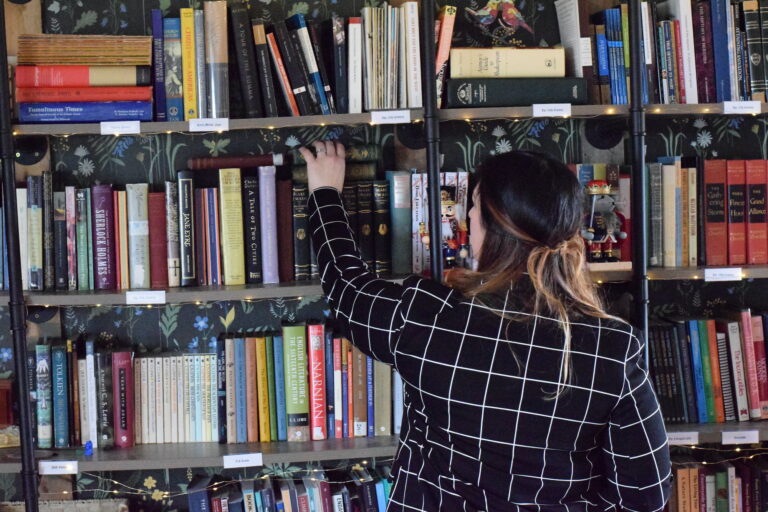

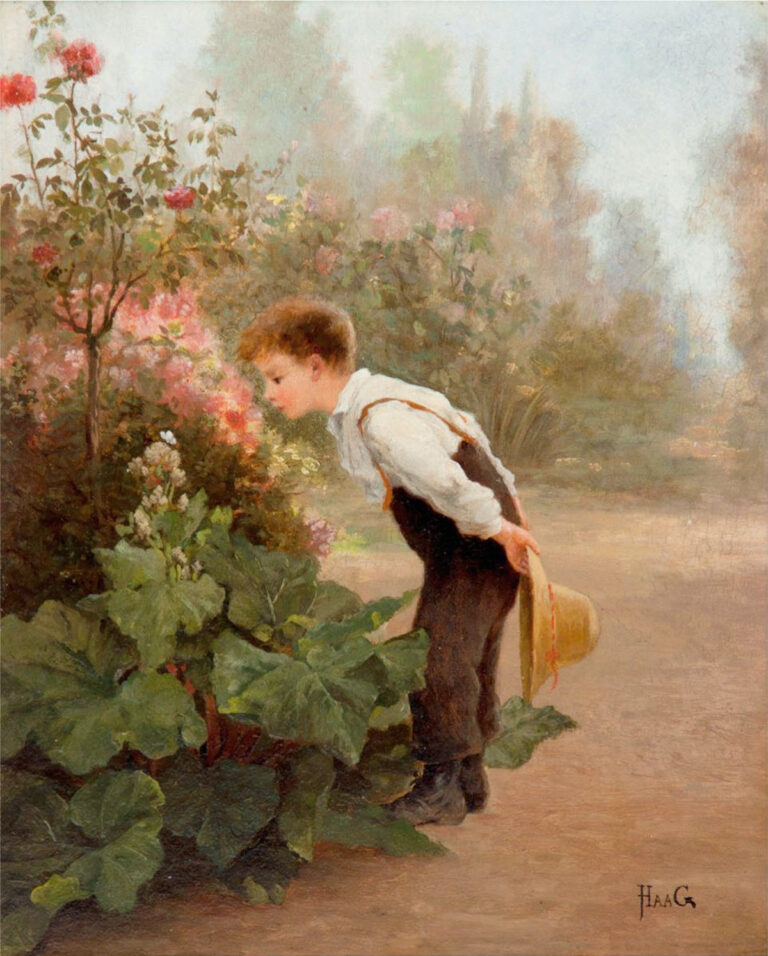
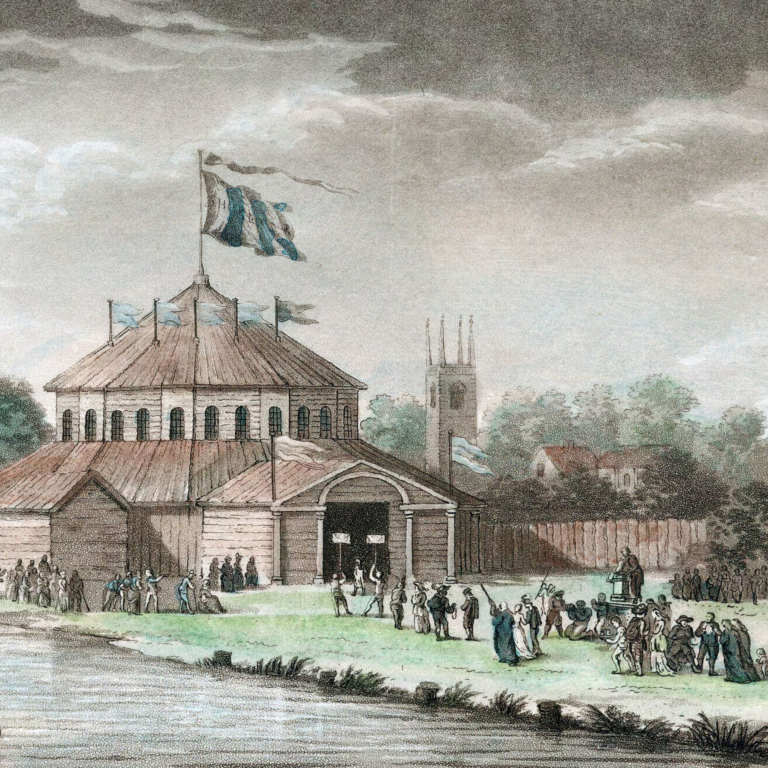
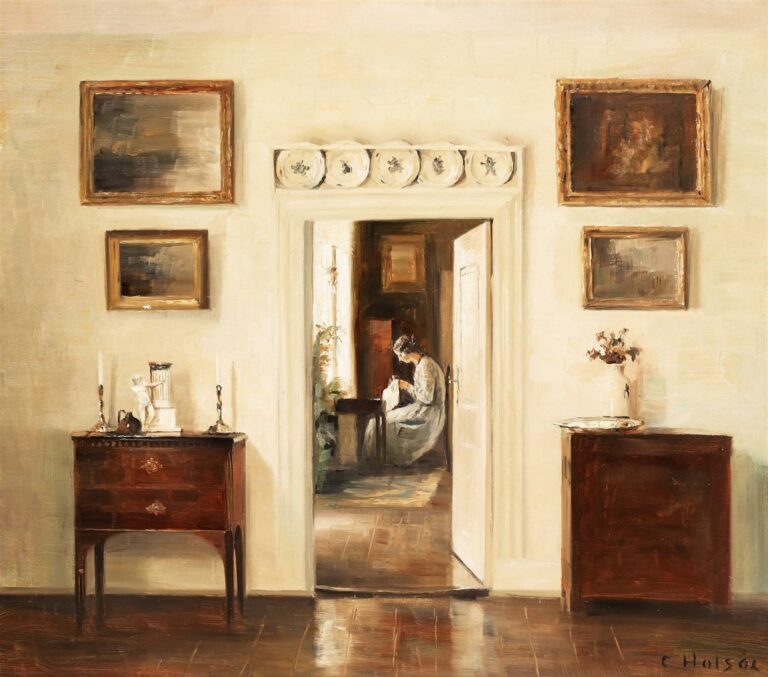
I love how you keep the Charlotte Mason approach. I very much needed to read this to remind me why I started homeschooling. Is there a Charlotte Mason book you recommend for someone who doesn’t know this method?
Hello Miriam, thank you! 🙂 I would say that a great place to start is with the book “For the Children’s Sake” (https://amzn.to/49E1wCB) this is a great primer or beginner text that I found so helpful. Then there is the first book from Charlotte Mason herself, “Home Education” (https://amzn.to/47SzNwA). Hope that you find these helpful!
-Mary